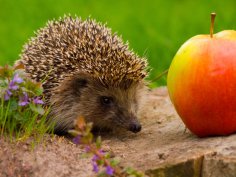
Oddly enough, the small prickly hedgehog occupies a special place in Slavic mythology.
Since ancient times, the Slavs have fought evil spirits with amulets associated with the hedgehog, and with the help of these small creatures they treated serious illnesses.
According to legend, the hedgehog is so wise that even God, when creating the earth, heeded its advice. Other legends, however, place the hedgehog's origins in doubt: a devil sat on a tree stump, combed his fur, and threw the hair onto the ground, which subsequently transformed into a hedgehog.
The Bulgarians considered the hedgehog to be the wisest of all, as it lives a long time in the world and remembers everything that has ever happened before, and it also knows how to use a special rejuvenating herb and therefore never ages.
Residents of Polesia consider the hedgehog a good herbalist. According to legend, in addition to the “herb of youth,” he knows where the so-called “tear-herb” grows, which opens all locks and bolts. To obtain this herb, a person must find a hedgehog's nest and block the entrance with stones. The mother hedgehog, seeing that she can't reach her babies, will surely seek out the “tear-herb” and destroy the barrier.
There are many legends about this cute creature; for example, the ancient Slavs attributed to the hedgehog the ability to drive away evil spirits, thanks to its spines.
The Poles baked bread in the shape of a hedgehog for weddings, and the Russians used a “hedgehog” kalach, decorated with painted straws instead of needles, as a talisman for the bride and groom on their wedding night.
Serbs used a hedgehog's muzzle as a remedy against the evil eye, and its heart was considered a talisman against illness. Hedgehog fat was considered the best cure for rheumatism and fever. The same fat was used to treat fly and mosquito bites. And hedgehog urine was mixed into vodka for alcoholics to quit drinking.
Hedgehogs have always been a convenient treatment because they live near villages. After all, cow's or goat's milk is a great delicacy for hedgehogs. There's even a belief that they can produce milk themselves, but they remember milking times well and regularly come to the milking station, waiting for a trickle to spill past the bucket. Kind housewives even pour out a whole saucer of milk just for the hedgehogs.
Farmers always considered the hedgehog a fortunate neighbor, feeding it and never killing it. Unlike other animals that live in communes, the hedgehog lives in splendid isolation. It occupies an area of up to two hectares for its sole use. The appearance of another hedgehog on the property is perceived as an intrusion and immediately begins an active fight to eliminate the rival. Despite its small stature, the hedgehog fights to the bitter end, using not only its quills but also its sharp teeth.
The hedgehog is also a fierce opponent of snakes and will never yield to them. It doesn't specifically hunt snakes, preferring small insects, worms, and mice as food, and also enjoys berries and bird eggs. However, if a snake enters the hedgehog's territory, a fight is inevitable. The reptile's venomous teeth encounter the spines, exhausting the snake in the grueling struggle. As the victor, the hedgehog consumes the prey, leaving only the head with its venomous fangs, despite its strong immunity to poison. Even strong poisons such as potassium cyanide or arsenic (though in small quantities) are tolerated by the hedgehog.
So the villagers choose such a nice neighbor. The hedgehog cleans the field of small rodents and drives away snakes. Being selfish by nature, he doesn't allow other animals onto his territory, except for the female during mating season.
One can only be amazed, looking at this small creature, at how it adapts to life, how it can skillfully fight its enemies, and most importantly, how it can help people.





